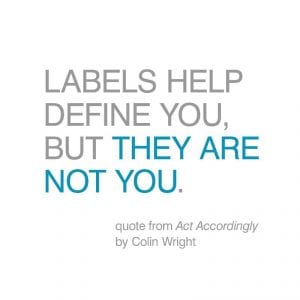At the end of my last blog post, Get Your Whistle, I mentioned I would be coming back to talk more about personality styles and here it is! But….
Labels
Before I head into specific personality styles, I wanted to take a moment to address labels. Just yesterday I was in a meeting and we were talking about a presentation where the speaker mentioned the need to “throw out labels!” Labels box people in! They limit expectations! They act as excuses! My heart is thinking, “Yes”! I don’t want to limit anyone! Throw them away!
Later that day I headed to a data meeting. During that meeting, each student was discussed and there was the opportunity to identify students’ need. Here teachers,interventionists, a psychologist, a social worker, and administration talk about the life situations that have come up that may be challenging that student. Labels are placed on students and I am thinking, “Yes”! These students are going to get the services they need because we are identifying the strengths and challenges in their lives and doing something about it!
Labels. Can they be limiting? Yes. Are they helpful? Yes.
Labels are a necessity in education. It is important that we can identify the strengths of our students and where they need more support. We need to know what their home life is like so we can connect and support it in the learning environment. We need to know if a student is a struggling reader or enriched in math. We need to know so that we can reach them and teach them appropriately. We need those labels.
On the other hand, do not let those labels limit. They are there to inform practice not set limitations or act as excuses when goals aren’t met. Labels help us connect our own prior knowledge and be able to address situations in a more appropriate fashion. It is vital for me to know when I am pushing s student outside of his/her label and to add in that extra support to let them know that I am aware that this is going to be a challenge for him/her but I think he/she can do it. Labels are not excuses.
Personality Types
Jane Kise, in Differentiated Coaching: A Framework for Helping Educators CHANGE, asks for the reader to take a moment and sign your name with you dominant hand. When you finish you are tasked with signing your name in your non-dominant hand. Try it.
How did it feel to use your non dominant hand? You could most likely still sign you name, but you most likely found it wasn’t as simple or natural as it was with your dominant hand. People are born with a natural preference for writing with their right or left hand. You may practice and strengthen the ability to use the other hand, but naturally you prefer one hand over the other. Keep this activity in mind as you look at personality types.
Let’s go back to the core of this blog post. Last month I wrote about the four coaching styles and went through a quick rundown of who may fit into each coaching style. I discussed the need for teachers to step into the coaching role for their students as we move deeper into the world of personalized learning. Today’s post is getting into more detail and giving you a better opportunity to label your students personality type as well as your own.
Look through the descriptions below to help guide yourself to identifying which personality type you may be and to start to identify what students in your room may have a natural preference for. These are all from Differentiated Coaching: A Framework for Helping Educators CHANGE by Jane Kise. I highly recommend reading the book for a more in depth look at the types and to utilize a professional type preference tool such as TypeCoach, MBTIⓇ, PPIⓇ, PTIⓇ, JTIⓇ, or GPTPⓇ (avoid anything free).


If you take the initial associated with each trait you will have the overall personality type. (Use for reference below)
Can you categorize some of your students? Can you identify what they may naturally prefer? What about for yourself? Remember, you want to coach your students in a way that fits their individual styles. This may be far from your style. Being aware of what works for you is important to know for your own growth, but is also significant to note that is the way you most naturally approach coaching your students.
So now what? What do you do with these labels? How do these fit into coaching styles? Take a look at the chart below. Kise’s created this chart to identify how each types likes to be coached. Select one of the students in your class. See if you can use the chart above to estimate what his/her personality type is. How do they need to be coached?

*Chart 7.5 found on p. 126 of Differentiated Coaching: a Framework for Helping Educators Change
Can you use this information to connect with a student you have been struggling to coach? Can you use knowledge of your own personality type to inform a coworker about a way that you feel you could collaborate better? Can you change the way you approach working with a team member by looking and identifying what work best for their personality and finding a way to work with that? Acknowledging our own personalities, identifying the personalities of those around us, and being able to verbalize these needs/wants creates a situation where collaboration can occur. No personality is right and no personality is wrong, they all just need something a little different and knowing that is the first step to getting everyone involved to where they want to be.
Kise, Jane A. G. Differentiated Coaching: a Framework for Helping Educators Change. 2nd ed., Corwin, 2017.